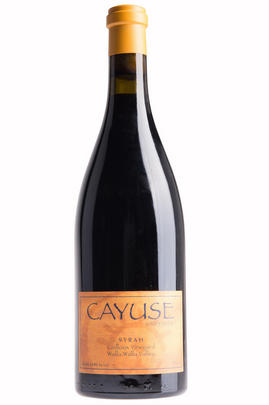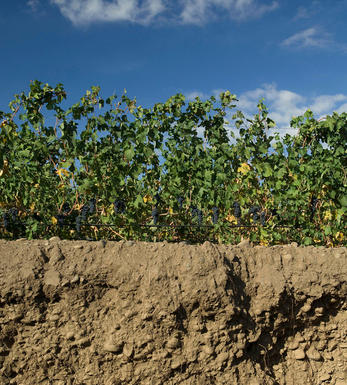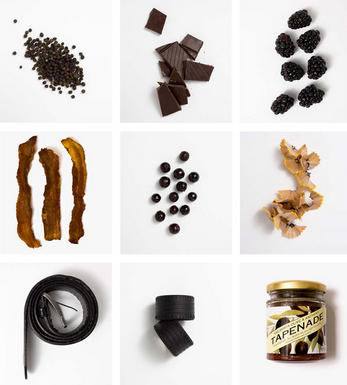
2016 Cayuse Vineyards, Cailloux Syrah, Walla Walla Valley, Washington, USA

Critics reviews
The 2016 Syrah Cailloux Vineyard is co-fermented with 4% Viognier in a Côte-Rôtie style that delivers a red and black-fruited nose with a floral grip and rustic rockiness. It is medium to full-bodied on the palate, with a soft smokiness and olive notes, resulting in an exquisite and structured wine with a focus on terroir. It is thoughtfully balanced on the long-lingering finish with a tannic edge and lifting acidity. This is really well-made wine with a production of only 829 cases.
Drink 2019 - 2040
Anthony Mueller, Wine Advocate (Dec 2019)
This syrah is co-fermented with some viognier (the only Cayuse wine to do this) and it has an ethereal edge of yellow plums, white pepper, bacon fat and flowers, all in the mix. A lot of whole-cluster influence here (60-70%). The palate has such deep-set fresh fruit and an attractive, long and juicy feel that carries a silky, long finish. Effortlessly exotic. Drink or hold.
James Suckling, jamessuckling.com (Jul 2019)
Always from a mix of vineyards and made with the idea of a great Côte Rôtie, the 2016 Syrah Walla Walla #10 offers a huge nose of raspberries, violets, crushed rocks, smoked earth, and salted meats. It's another seamless, gorgeously balanced, elegant wine that has an awesome character and length.
Drink 2022-2037
Jeb Dunnuck, jebdunnuck.com (Apr 2019)
Bright dark red. Alluring savory perfume of raspberry, smoke, pork rind, African violet and red licorice. Wonderfully fine-grained, pretty wine with terrific energy and inner-mouth lift, but still youthfully tight and in need of aging compared to Elizabeth Bourcier's own No Girls Syrah. The flavors of red fruits and spices are perked up by a suggestion of apricot pit that I often find in Côte-Rôties made with a bit of Viognier. This beautifully filled-in midweight boasts stunning aromatic complexity--and its perfumed complexity belies its 4.0 pH. (vinified with 70% whole clusters; aged in 15% new demi-muids)
Drink 2021 - 2031
Stephen Tanzer, vinous.com (Jun 2018)
About this WINE

Cayuse Vineyards
Cayuse Vineyards is one of the leading wine producers in Washington State, owned and run by Frenchman Cristophe Baron. Cayuse's single vineyard Syrahs have become incredibly sought after and are compared with the finest wines from the Northern Rhone.
Christophe Baron grew up among the vineyards and cellars of his family's centuries-old Champagne house, Baron Albert and became the first Frenchman to establish an estate domaine in Washington State. While visiting the Walla Walla Valley in 1996, Christophe spotted a plot of land that had been plowed up to reveal acres of softball-sized stones.
He became ridiculously excited. This stony soil, this terroir, reminded him of vineyards he had visited in France and Spain. The difficult ground would stress the grapevines, making them produce more mature, concentrated fruit. Christophe Baron had found a new home.
The majority of the vineyard is planted with Syrah, and the rest dedicated to Cabernet Franc, Cabernet Sauvignon, Grenache, Merlot, Tempranillo and Viognier. All of the vineyards are planted in rocky earth within the Walla Walla Valley appellation. Cayuse is also the first domaine in Walla Walla to farm using biodynamic methods.

Washington State
Washington State is the United State’s second-largest wine region, second only to California. The first grapes were planted here in 1825, though it wasn’t until 1960 that the first commercial vineyards were planted.
The state has 20 American Viticultural Areas (AVAs). The first, Yakima Valley, was established in 1983. Columbia Valley AVA is the largest; the region is shared between Washington and neighboring Oregon. Other notable AVAs include Walla Walla Valley, Puget Sound, Red Mountain, and Horse Heaven Hills.
Washington’s largest producer, Chateau Ste. Michelle was founded in 1967. Today, there are over 1,000 wineries in the state, along with over 400 winegrowers. Among the leading producers here are Cayuse Vineyards, Horsepower Vineyards, and Hors Catégorie Vineyards.
A wide range of grape varieties is grown here, with Cabernet Sauvignon the most widely planted, followed by Chardonnay, Riesling, Merlot, and Syrah.

Syrah/Shiraz
A noble black grape variety grown particularly in the Northern Rhône where it produces the great red wines of Hermitage, Cote Rôtie and Cornas, and in Australia where it produces wines of startling depth and intensity. Reasonably low yields are a crucial factor for quality as is picking at optimum ripeness. Its heartland, Hermitage and Côte Rôtie, consists of 270 hectares of steeply terraced vineyards producing wines that brim with pepper, spices, tar and black treacle when young. After 5-10 years they become smooth and velvety with pronounced fruit characteristics of damsons, raspberries, blackcurrants and loganberries.
It is now grown extensively in the Southern Rhône where it is blended with Grenache and Mourvèdre to produce the great red wines of Châteauneuf du Pape and Gigondas amongst others. Its spiritual home in Australia is the Barossa Valley, where there are plantings dating as far back as 1860. Australian Shiraz tends to be sweeter than its Northern Rhône counterpart and the best examples are redolent of new leather, dark chocolate, liquorice, and prunes and display a blackcurrant lusciousness.
South African producers such as Eben Sadie are now producing world- class Shiraz wines that represent astonishing value for money.


Buying options
Add to wishlist
Description
The 2016 Syrah Cailloux Vineyard is co-fermented with 4% Viognier in a Côte-Rôtie style that delivers a red and black-fruited nose with a floral grip and rustic rockiness. It is medium to full-bodied on the palate, with a soft smokiness and olive notes, resulting in an exquisite and structured wine with a focus on terroir. It is thoughtfully balanced on the long-lingering finish with a tannic edge and lifting acidity. This is really well-made wine with a production of only 829 cases.
Drink 2019 - 2040
Anthony Mueller, Wine Advocate (Dec 2019)
wine at a glance
Delivery and quality guarantee